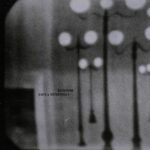DICTAPHONE – GOATS & DISTORTIONS 5
I don’t know when music is called ‘dark jazz’ but what I do know is that I almost always like music that is labeled as such. In the case of (Belgian-German) band Dictaphone, I can understand the ‘jazz’ aspect because of the extensive use of clarinet/saxophone in a (seemingly) improvisational context. But is this ‘dark’? I don’t experience it that way myself – I’d rather call it ‘unconventional’- but maybe that tells more about me than about the music. Darkness, after all, is in the eye or ear of the beholder.
Goats & Distortions 5 is Dictaphone‘s fifth album, diving deeper into what they call their ‘morbid instruments’ concept. Before I raise the same question again (when is an instrument called ‘morbid’?), the answer is already given: these recordings started with the samples from “an old tape machine, which Doerell found in a hidden room in his house in Berlin, [on which] ghostly sounds could be heard”.
The machine died soon after being sampled.
These ghostly remains can be heard all over the album, in compositions Oliver Doerell created together with Roger Döring (saxophone and bass clarinet – which he lost in the subway after recording, which is morbid too) and Alex Stolze (violins).
The result is a unique combination of sounds, a boundless approach that merges different genres, creating a whole new genre in itself. A genre for which the right name has yet to be found.
JASON SHARP – THE TURNING CENTRE OF A STILL WORLD
Jason Sharp is a saxophonist and electroacoustic composer from Montréal. The first two tracks on The Turning Centre Of A Still World immediately clarify what this combination means: the intro (called Intro) is a saxophone-centered track, perhaps simply to get in the mood, but is followed up by Unwinding Surrender, where the frenzied sax-loops are still recognizable as such but turn into a clearly electronic composition.
The saxophone may be his primary instrument, but on the whole Sharp’s third solo album on the Constellation label feels like (in his own words) “a singular sonic exploration of human/machine calibration, interaction, expression and biofeedback.”
The ‘biofeedback’ referring to the recording setup, using “saxophones, foot-controlled bass pedals, and his own pulse – patched through a heart monitor routed to variegated signal paths that trigger modular synthesizers and samplers.”
As ‘electronic’ (as opposed to ‘organic’) as it may sound, the music literally has an organic heartbeat, since Sharp’s heartbeat was always at the core of these compositions (sometimes clearly audible, too, as in Blossoming Rest).
This – the pulse-driven electronics combined with the saxophone riffs, even if these are hidden deep in electronic layers – results in an extra depth in the music.
A cyborg-like presence can be felt throughout.




